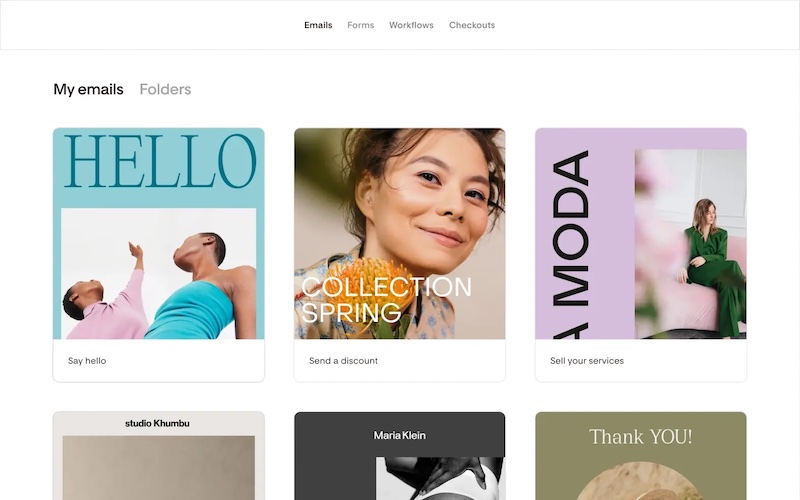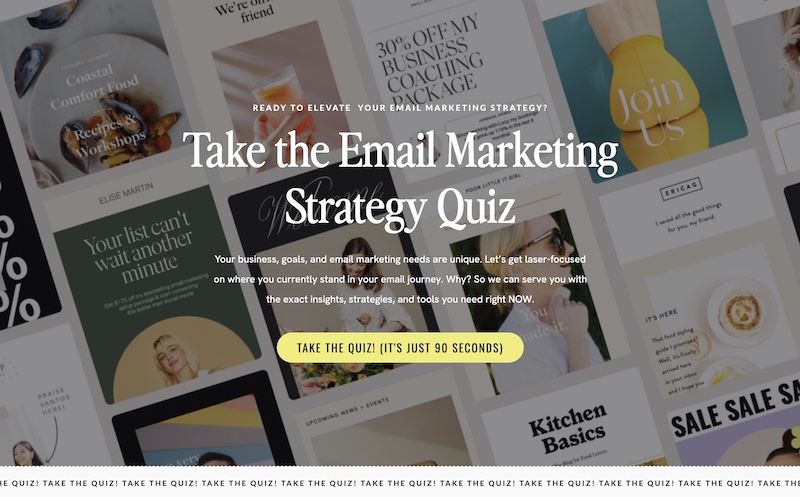Sarah
Posted By:
50 Common Email Marketing Mistakes Online Brands Make Every Day
October 18, 2023
•
Sarah Flowers Copywriter is a participant in the Amazon Services LLC Associates Program, an affiliate advertising program designed to provide a way for websites to earn advertising revenues by advertising and linking to Amazon.com.
Finally, an intuitive website builder that's beautiful, functional, and great for SEO—what more could you want?!
Click here to get your first month free!
Showit
Amazon Affiliate Disclosure
03
Start selling online with beautiful sales pages, online payments, and instant product delivery, all in one place. Try it for free—no credit card required!
Flodesk Checkout
02
An email marketing platform that can match your brand's aesthetic without sacrificing marketing power. Quite simply, the best of both worlds.
Flodesk
01
A Few of My Favorite Things
Take the Quiz
Find out in just 60 seconds + get a FREE 5-Day Email Course tailored to your skill level!
How's Your Email Marketing
Free Quiz
really?
More About Me ›
Hey there, I'm Sarah! I share all the best email marketing, biz, and copywriting tips to help you scale your online business in record time. Come for marketing ideas, and stay for updates and community.
Welcome!
Sarah
Posted By:
Discover the 50 Common Email Marketing Mistakes coaches, creatives, influencers, and modern online brands make—and how to avoid them.
Email marketing is crucial for online brands, coaches, creatives, and influencers. It is one of the most effective ways of reaching out to a large number of people and building relationships with them.
However, email marketing can be overwhelming and time-consuming, and oftentimes, mistakes are bound to happen. Knowing what these mistakes are and how to avoid them can make all the difference in your email marketing campaigns.
In this blog post, we will dive into the most common email marketing mistakes that coaches, creatives, influencers, and modern online brands make, and more importantly, how to avoid them.
Common Email Marketing Mistakes Coaches, Creatives, Influencers, and Modern Online Brands Make—and How to Avoid Them
1. Not Using a Welcome Email Series
A welcome email series can help engage new subscribers and set expectations for your future emails. Not setting up a welcome series can mean missing out on an important engagement opportunity.
2. Failing to Use a Professional Email Service Provider
Using a professional email service provider ensures your emails are delivered properly, provides you with necessary analytics, and offers features for optimization. Trying to manage your email campaigns without one can lead to various technical issues and inefficiencies.
Related: Why We Love Flodesk
3. Not Providing Value in Your Emails
Your subscribers opted in to receive your emails because they believe they will benefit from what you have to offer. Sending emails that are purely promotional or salesy can be a quick way to lose subscribers.
Make sure to add value to your emails by providing educational content, inspiring stories, and actionable advice. Aim to make your emails a source of inspiration and entertainment for your subscribers.
By doing so, you’ll build a stronger relationship with them, which can lead to more sales and loyal customers.
4. Not Aligning Your Email and Brand Voice
Your emails should reflect your brand’s voice and tone. Failing to align these can lead to confusion and a lack of brand consistency.
5. Sending Too Many Emails
While email marketing is a powerful tool, it’s important to strike the right balance in terms of frequency. Sending too many emails can lead to “email fatigue” where subscribers become overwhelmed and start ignoring your messages, or worse, unsubscribe altogether.
According to The Loop Marketing, if your list is smaller than 2,000, sending out 4 to 8 emails a month would be the maximum. Overloading your subscribers with emails not only reduces the effectiveness of your communication but could also lead to your emails being marked as spam.
6. Not Sending Enough Emails
On the other hand, not sending enough emails can also be a problem. If you’re not communicating regularly with your subscribers, they may forget about your brand or miss out on important updates or offers.
However, it’s crucial that each email provides value—sending frequent emails without saying anything important can make your emails seem not worth opening. It’s all about finding the sweet spot between staying top-of-mind and avoiding overwhelming your subscribers.
Regularly testing and adjusting your email frequency based on your audience’s engagement can help you find this balance.
Related: How Often Should You Email Your List?

7. Sending Emails Without Segmenting Your List
Sending emails to your entire list without segmenting can be a costly mistake. It’s important to understand that not everyone on your list is interested in every aspect of your brand or what you have to offer.
Segmenting your list based on their interests, past purchases, behavior, and demographics can help you personalize your message and improve engagement. Sending relevant and personalized content to your audience can increase your open and click rates, leading to more sales and conversions.
Learn more about segmenting your email list here: Email List Segmentation: Why It’s Your Best Bud.
8. Ignoring Mobile Optimization
According to a study by Campaign Monitor, over 54% of emails are opened on mobile devices. If your emails are not optimized for mobile devices, you risk losing a significant percentage of your audience.
Make sure your email templates are responsive and mobile-friendly. Test your messages on different devices and make sure they look and function well on all of them.
Most importantly, keep your message short and sweet, with clear calls to action, to increase the chances of your recipients taking action.
9. Not Optimizing for Different Email Clients
Different email clients (like Gmail, Yahoo, Outlook) display emails slightly differently. If you’re not optimizing your emails for these different clients, your subscribers might not be seeing your emails as you intended.
10. Neglecting Your Subject Line
Your subject line is the first thing your subscribers see when they receive your email. Neglecting your subject line can lead to low open rates and missed opportunities. Your subject line needs to be catchy, relevant, and concise.
It should entice your subscribers to click and read your message. Test different subject lines to see what works best for your audience, and don’t be afraid to get creative with them.
However, avoid clickbait subject lines that misrepresent the content of your message. It can lead to distrust and can damage your brand reputation.
Learn how to write email subject lines that convert:
How to Craft Irresistible Email Subject Lines
The Psychology Behind Effective Email Subject Lines
11. Inconsistent Email Sending Schedule
Inconsistency in sending your emails can confuse your audience and lead to lower open rates or even unsubscribes. Having a regular schedule for your emails helps to set expectations and keep your subscribers engaged.
Whether you choose to send emails daily, weekly, or monthly, stick to a consistent schedule that matches your content production and audience preference.

12. Overlooking the Importance of a Clear Call-to-Action
Every email you send should have a specific purpose and a clear call-to-action (CTA). Whether it’s to read a blog post, check out a new product, or sign up for a webinar—make sure your audience knows exactly what they’re supposed to do next. A vague or missing CTA can lead to lower engagement and conversion rates.
13. Neglecting to Personalize Emails
Personalizing your emails can significantly improve your open and click-through rates. This goes beyond just using the recipient’s name in the email.
Personalization can include tailoring the content based on their preferences, behavior, or past interactions. Neglecting to personalize your emails can lead to less engagement and a less effective email marketing strategy.
14. Failing to Clean Your Email List Regularly
A clean email list is essential for maintaining high deliverability rates and avoiding spam filters. Regularly remove inactive subscribers and those who have not opened or clicked on your emails in a while.
This practice ensures that your emails are going to people who are genuinely interested in your brand and helps to improve your overall email marketing performance.
15. Ignoring Feedback and Subscriber Preferences
Lastly, ignoring feedback from your subscribers or not giving them options to control what kind of emails they receive can be detrimental. Always be open to feedback and make necessary adjustments based on it.
Also, consider providing options for subscribers to choose the type of content they want to receive or how often they want to hear from you. This can improve your relationship with your subscribers and increase engagement.
16. Sending Emails Without Proper Permission
Obtaining proper permission before adding someone to your email list is not only respectful but also complies with various privacy laws. Failing to do so can harm your reputation and potentially result in legal issues.
17. Overloading Emails with Information
While it’s important to provide value, overloading your emails with too much information can be overwhelming for your subscribers. Keep your emails concise and focused on one main topic or call-to-action.
18. Not Testing and Analyzing Your Email Campaigns
Testing and analyzing your email campaigns is essential to improving your email marketing strategy. Not doing so can lead to missed opportunities for growth and optimization.
Testing different elements like your subject lines, content, images, and delivery times can help you understand what works best for your audience. Analyzing your campaigns’ performance can give you valuable insights into your subscribers’ behavior and preferences.
Use these insights to improve your campaigns, drive better results, and build stronger relationships with your subscribers.
19. Failing to Re-engage Inactive Subscribers
Inactive subscribers can drag down your engagement rates. Instead of just ignoring them, try sending re-engagement campaigns to get them interested in your brand again.
20. Overlooking Email Automation
Email automation allows you to send timely, personalized emails to your subscribers without having to manually send each one. Not utilizing this tool can lead to missed opportunities and inefficient use of your time.
21. Not A/B Testing Your Emails
A/B testing different elements of your emails (like subject lines, content, design) can provide valuable insights into what works best for your audience. Failing to do this means you could be missing out on potential improvements to your campaigns.

22. Underestimating the Importance of Strong Preview Text
The preview text gives subscribers a sneak peek into your email content. Not optimizing it can lead to lower open rates.
23. Sending Emails at Inopportune Times
The timing of your emails can significantly affect open rates. Sending them when your audience is most likely to be checking their inbox can increase engagement.
24. Not Using Analytics to Guide Strategy
Email marketing analytics provide crucial insights into your campaign performance. Not utilizing these metrics can lead to uninformed decision-making.
25. Using Generic “No-Reply” Sender Addresses
A no-reply email address can come across as impersonal and discourage engagement. Using a real reply-to email address can foster a more personal connection with your subscribers.
26. Forgetting to Proofread
Typos and grammatical errors look unprofessional and can harm your credibility. Always proofread your emails before sending them.
27. Not Balancing Promotional and Informational Content
Constantly sending promotional content can be off-putting for subscribers. It’s important to balance it with valuable informational content to keep your audience engaged.
28. Not Using Behavior Triggers
Behavioral triggers, such as sending an email when a subscriber abandons their cart, can improve your conversion rates. Not utilizing these can mean missing out on potential sales.
29. Not Including an Unsubscribe Link
Failing to include an easy way for subscribers to opt-out can frustrate them and harm your brand reputation. It’s also illegal.
According to the CAN-SPAM Act of 2003, it is illegal not to include a clear and conspicuous way for recipients to opt out of receiving future emails from you. This usually takes the form of an unsubscribe link at the bottom of the email.
Violating this law can result in hefty fines. Beyond the legal repercussions, not including an unsubscribe option can lead to increased spam complaints, which hurt your email deliverability rates.
It can also negatively impact your brand reputation, as it shows a lack of respect for your subscribers’ preferences and privacy.
But don’t worry, if you use an email client like Flodesk, they will automatically make sure you include the unsubscribe link and follow other email laws, depending on which countries you send you emails.

30. Using Spam Trigger Words
Certain words and phrases can trigger spam filters, causing your emails to end up in the spam folder. Being aware of and avoiding these can improve your deliverability rates.
31. Not Creating a Sense of Urgency
Creating a sense of urgency can motivate subscribers to take action. Failing to do so can lead to missed conversion opportunities.
32. Not Regularly Updating Your Email Design
Keeping your email design fresh and current can help maintain interest and engagement. Ignoring this can lead to stale and outdated-looking emails.
33. Not Using Social Proof
Including social proof, like testimonials or reviews, can increase trust and credibility. Not including these can mean missing out on a powerful persuasion tool.

34. Ignoring Customer Retention Emails
Customer retention emails, like re-engagement campaigns or anniversary emails, can help maintain relationships with your subscribers. Ignoring these can lead to lost customers.
35. Not Offering Exclusive Content or Discounts to Subscribers
Offering exclusive content or discounts can incentivize people to subscribe and stay subscribed to your emails. Not offering these can result in lower subscription and retention rates.
36. Neglecting to Send Transactional Emails
Transactional emails, like order confirmations or shipping notifications, are highly anticipated and have high open rates. Neglecting to send these can lead to poor customer experience.
37. Not Using Images Effectively
Images can help break up text and make your emails more engaging. However, using too many images or images that are too large can slow download times and detract from your message.

38. Ignoring the Power of Storytelling
Storytelling can help make your emails more engaging and memorable. Ignoring this can result in less impactful emails.
39. Not Optimizing Your Email for Dark Mode
With the increasing popularity of dark mode, optimizing your email design for it can improve readability and user experience.
40. Ignoring the Importance of Email Accessibility
Making your emails accessible to people with disabilities is not only the right thing to do but can also increase your audience reach. Ignoring accessibility can lead to lost opportunities and potential legal issues.
41. Ignoring the Power of Retargeting
Retargeting allows you to re-engage subscribers who have shown interest in your products or services. Ignoring this strategy can lead to missed opportunities.
42. Relying Only on Text
While text is important, visual elements like images, infographics, and videos can make your emails more engaging. Relying only on text can result in dull and less attractive emails.
43. Failing to Use Clear and Concise Language
Overly complex language can muddle your message and turn readers away. Be sure to aim for clarity and simplicity in your emails.
Remember, effective copywriting, especially in the business world, is often crafted to be easily understood by a broad audience, typically at around a 4th grade reading level.
This ensures your message is digestible and engaging, regardless of your reader’s background or skill level.
44. Not Using Landing Pages
Landing pages can be a powerful tool for converting email leads into customers. If you’re not directing your email traffic to well-crafted landing pages, you’re potentially missing out on conversions.

45. Forgetting to Add Alt Text to Images
Alt text ensures that even if an image doesn’t load, or if your reader is visually impaired, they’ll still understand the context of the image. Ignoring this can lead to accessibility issues and misunderstandings.
46. Forgetting to Encourage Social Sharing
Encouraging readers to share your email content on their social networks can greatly extend your reach. If you’re not taking advantage of this, you’re potentially missing out on a lot of exposure.
47. Failing to Use Dynamic Content
Dynamic content changes based on the user’s behavior, preferences, or demographics, making your emails more relevant and engaging. Not using dynamic content can result in less personalized and effective emails.
48. Not Testing Different Types of Email Campaigns
There are various types of email campaigns—welcome series, re-engagement, promotional, informational, etc. Not testing different types can limit your understanding of what works best for your audience.
49. Avoiding Plain Text Emails
While visually appealing emails have their place, plain text emails can often feel more personal and genuine. Completely avoiding them can mean missing out on a valuable engagement tool.
50. Relying Solely on Email Marketing
While email is a powerful marketing tool, it should be part of a broader multi-channel marketing strategy. Relying solely on email can limit your reach and potential for growth.

Wrapping Up
By avoiding these common mistakes in your email marketing, you can build a stronger connection with your audience, improve your campaign performance, and ultimately drive more conversions for your brand.
Remember, successful email marketing is about delivering the right message to the right person at the right time. With careful planning, testing, and optimization, you can make your email marketing strategy a powerful tool for your business growth.
More ways to grow your online brand:
25 Ways to Get More Done in Less Time
Boost Your Email Marketing ROI: What to Expect in Your FREE Email Audit
Why Every Online Business Needs a Lead Magnet
Why Even Top-Performing Brands and Influencers Need Email Marketing
5 Steps to Start an Email List Even If You Don’t Have a Business—or a Website!

Leave a Reply Cancel reply
Leave a Comment
Your email will not be published. Required fields are marked*
Next Post
Previous Post
SIGN ME UP!
Want the latest news, trends, and a dash of magic ✨ in your inbox?
Get Weekly Insider Tips
Join the Community
© Piperlane 2024 · All Rights Reserved · Get In Touch · Legal
© Piperlane 2024 · ALL RIGHTS RESERVED · LEGAL
Show Comments